How to install a sink with a pedestal: step-by-step installation instructions
Among all the possible types of sinks, the models on the pedestal seem the most optimal for a country house. They are suitable for bathrooms with the release of sewers in the floor. If this is your option, check out the design features of the device and the installation guide offered by our website.
We will tell you how to install a sink with a pedestal with your own hands. We offer detailed step-by-step instructions to everyone who wants to independently install plumbing fixtures of the “tulip” type. The article we have proposed thoroughly sets out all the subtle nuances of the process.
To ensure that the installation and connection of the sink on the pedestal is perfect, familiarize yourself with possible errors that may occur during operation - this will help to avoid them.
The content of the article:
What is the feature of installing a sink?
A washbasin with a pedestal is a functional and practical solution for the bathroom. Before proceeding directly to the installation process, look at your sink. Depending on the design, type of mount and type of pedestal, the installation procedure will be different.
What to look for?
The pedestal - sink stands - has two main functions:
- supporting;
- decorative.
The washbasin bowl is mounted on the foot so that part of the weight is distributed directly to the pedestal. This is especially important for bulky and heavy sinks, as a conventional wall mount may not withstand the load. This is the case when installing a tulip is a necessity.
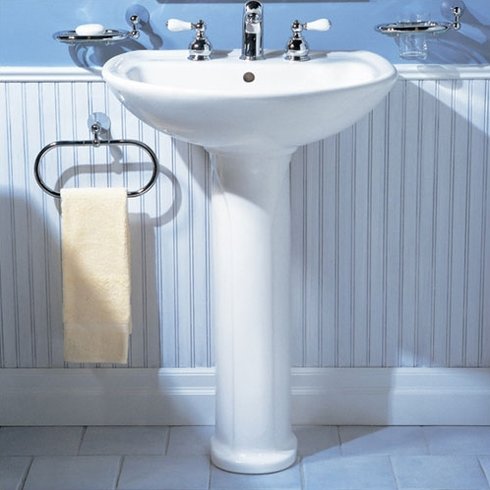
The decorative function of the pedestal is that it allows you to successfully mask the siphon, water and sewer pipes, which can spoil the appearance of the bathroom. Since the leg inside is hollow, all communications perfectly fit there.
To install the sink, it is important to determine the type of its design:
- monolithic;
- separate.
And also, with the location:
- angular;
- straight.
The monolithic shell-tulip is an indivisible design. This type of plumbing is stable, quite heavy and quite expensive. As a rule, these are premium models. It is not just about faience varieties. Apply natural and artificial stone, acrylic, glass.
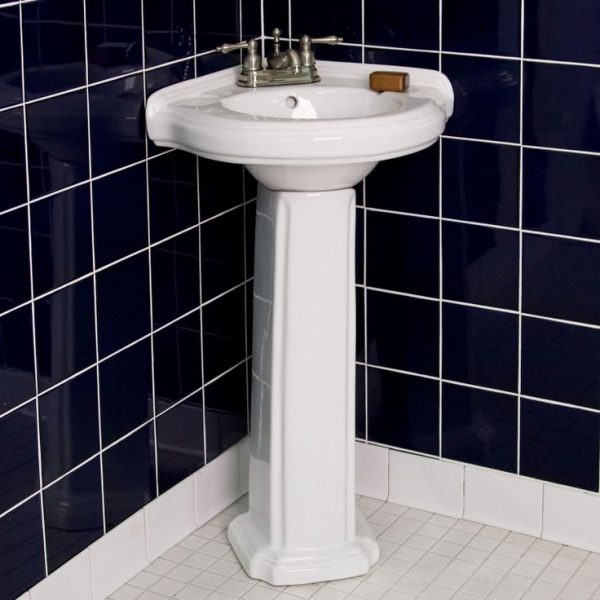
Manufacturers often offer a separate option: a sink and a pedestal for it from the same series. They are united by the same design and full compliance in terms of technical parameters. But it is not necessary to buy a washstand in the kit. The choice of sanitary ware is so large that choosing a suitable pair is not difficult.
How the sink will be located in your bathroom depends only on the availability of free space and your preferences. There are no big differences in installation technology.
What is a semi-pedestal and what are the features?
The semi-pedestal is a popular type of cup holder. In the interior design of the bathroom, it is now fashionable to use hanging plumbing: a toilet, bidet and washbasin, which do not rest on the floor, as usual, but are console mounted on the wall.
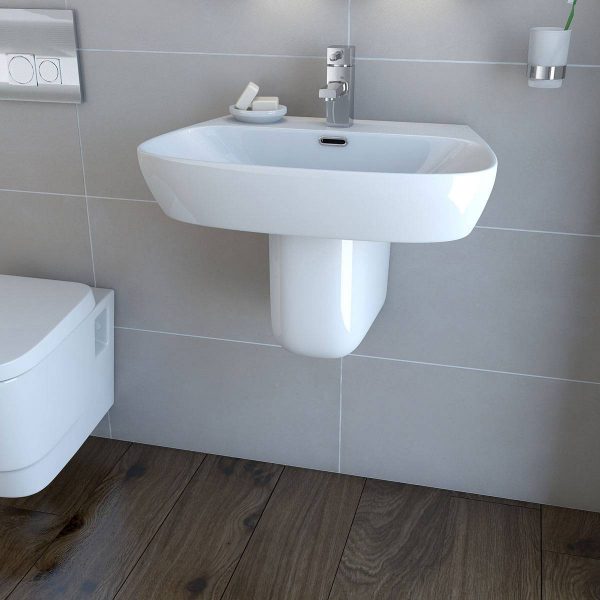
The semi-pedestal itself is a shortened leg. There is free space between it and the floor. It can be used rationally for storage, which cannot be done with a regular tulip. In addition, this design greatly facilitates cleaning under the plumbing - the floor remains free and hard to reach places are not formed.
As for the basic functions, the semi-pedestal copes well with both the aesthetic component (masking communications) and the supporting part. This type of sanitary ware can also be purchased separately, but it is important to adhere to the general idea of design and avoid mixing styles.
Calculations and dimensions for the wiring diagram
Before proceeding with the installation, you need to decide on the project. To get started, read the recommendations for installing a washbasin with a pedestal in the bathroom, and the rules bowl height, and then proceed with building a plan and calculating materials.
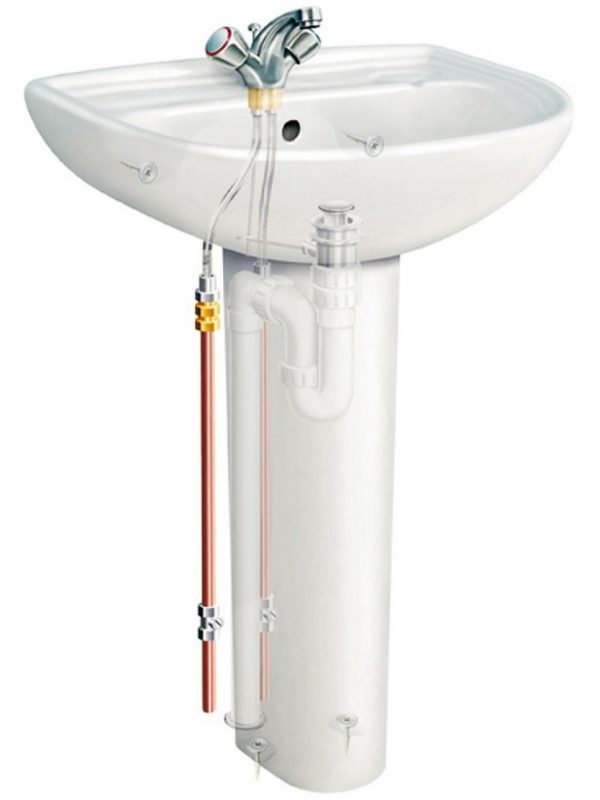
First of all, the size of the washbasin itself. It is better not to buy bowls less than 50 cm wide for a home. They will be inconvenient to use. The traditional size is 55-65 cm.The height of the sink should be selected depending on the growth of potential users.
There are standards that require the installation of a sink at a height of 80-82 cm from the floor. This size is optimal for most adults with a height of 160-180 cm. If you plan to buy a swivel mixer with a spout for the sink and bath, then you can move slightly away from the standards and set it at a height of 85 cm.

Nothing can stop you from installing the tulip wash basin higher, if that is more convenient for you. The height of the pedestal is usually about 65 cm, so you will not be able to mount the bowl below. But to make a raised platform under a tulip is not difficult.
Another important parameter that is often neglected due to the limited area in the bathroom is the space in front of the washbasin. There should be at least 70 cm of free space in front of the sink, otherwise it will be inconvenient to use it. It’s a bad idea to install a plumbing bowl in a narrow niche in the wall or between other interior items.
Each plumbing fixture has its own wiring diagram provided by the manufacturer.
It shows the basic data for installation:
- on which side the water is supplied;
- height of fixtures and main structural elements;
- location relative to the wall;
- the presence of overflow and holes for the mixer;
- dimensions of the device itself.
It is recommended to familiarize yourself with the wiring diagram of your plumbing fixture with a pedestal before installation, and if it comes to laying water pipes and sewers from scratch, then you need to do this already taking into account the features of the selected model of plumbing.
Installation Instructions - Step-by-Step Description
To make the installation process understandable, consider the technology in stages. Start by picking tools. Dismantling the old sink also needs to be done wisely. Then you need to take turns to install the sink, mixer, siphon and the pedestal itself.
Preparation of necessary tools and materials
If you have a wiring diagram in your hands and all communications are made in accordance with it, installing a sink with a pedestal is much easier and faster.
Prepare the necessary tools and materials:
- hammer drill;
- screwdriver or screwdriver;
- adjustable wrench;
- sealant;
- set of fasteners;
- washbasin siphon;
- mixer;
- roulette;
- building level.
Since the sink is initially mounted as a console, that is, it is rigidly fixed to the wall, a hammer is needed to drill holes in the concrete of the wall. A screwdriver or screwdriver is required to tighten the expansion bolt shields. To work with bolted joints, you will need an adjustable wrench.
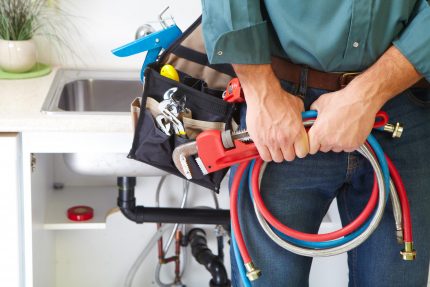
A set of fixtures, as a rule, comes standard with plumbing fixtures. Often a siphon is included. The mixer needs to be bought separately. Consider the depth and width of the sink when purchasing a faucet.
Roulette and the construction level are necessarily involved in all construction work, and the installation of a sink with a pedestal will not be an exception. You can’t even think of a pencil or marker for marking.
But the sealant, whether tow or FUM tape, must be present in the basic set of tools and materials without fail. Without proper sealing of all connections, no plumbing equipment can be operated.
Dismantling of old equipment
If your bathroom has already been equipped with a conventional sink, before installing the model with a pedestal, the old plumbing must be dismantled.
Make it simple:
- Shut off the water. Start by dismantling the mixer. Unscrew the nut and carefully disconnect the water pipes from the tap.
- Then remove the siphon. Despite the fact that the water is already blocked, part of it still remained in the pipes coming after the stop valves. So that after removing the siphon, all this water does not pour directly onto the floor, substitute a bucket or basin in advance.
- When the sink is no longer connected to the communications, you can begin to dismantle the sanitary ware. Unscrew the fasteners and remove the washbasin from the support.
The surface should be flat. If the floor in the bathroom, as is often the case, is crooked, it must be leveled with a cement screed.
If you make an additional elevation for the tulip, you can compensate for the bias due to it. Now it remains to free the room from the old plumbing in order to proceed to installation of new equipment.
Wall marking before installation
The next step is the installation of plumbing type “tulip”. The first thing to do is markup. You will need a wiring diagram that takes into account sink sizes.
Find the distance between the attachment points on it. Or just measure them with a tape measure. Measure the height at which the bowl will be mounted.
Draw a vertical line denoting the axis of symmetry. Relative to it will be installed. With a horizontal, level-adjusted line, mark the second axis - perpendicularly. Fasteners will be located on it.
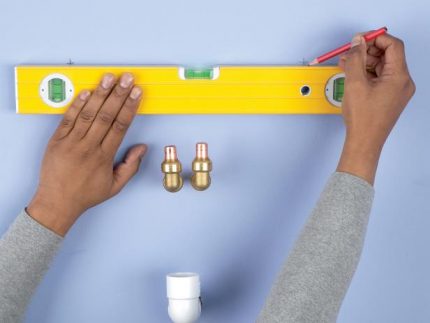
There is another simple markup method. Measure the desired height of the upper part of the sink, draw a horizontal line at this level. Connect the washbasin to the pedestal. Put the structure in place.
Make sure that the bowl and line on the wall are completely aligned. Take a simple pencil and insert it into the mounting holes. Draw marks on the wall in these places - you will get the exact location for the dowels.
Installing a basin mixer with pedestal
In order not to suffer with mixer installation on the installed sink, it is better to do everything in advance. Then there will be no need to climb into hard-to-reach places with a wrench and a screwdriver, you just have to connect the water supply.
Connect the purchased faucet with flexible pipes that you will connect to the water supply. Most often, this is a metal hose or rubber hose protected by a metal braid. All threaded connections must be made with a rubber gasket.
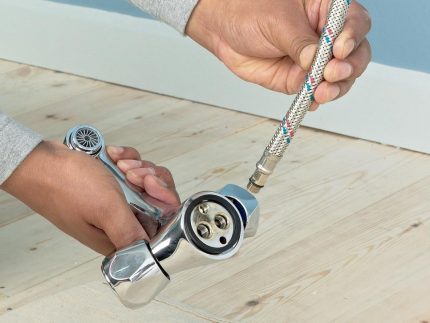
In the kit for the mixer you will find a connecting pin (or two). Screw it into the threaded hole at the bottom of the mixer. Put on a sealing ring. It will protect the shell material with a pedestal on top and prevent loosening.

Pass the faucet through the hole in the washbasin.
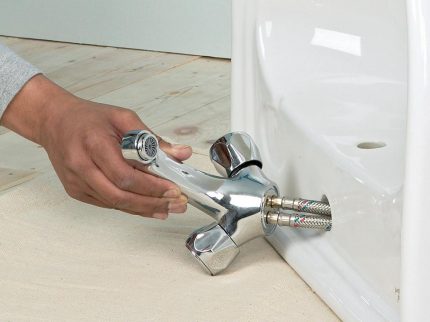
From below put on one more sealing ring - for protection from below. Sealing is necessary so that during operation the crane does not begin to stagger and “walk”. Take the special horseshoe-shaped metal washer and put it on the hairpin. It is needed for a stronger hold across the entire area.
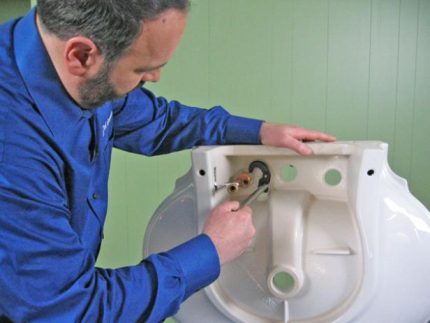
Screw the nut onto the stud with a wrench.
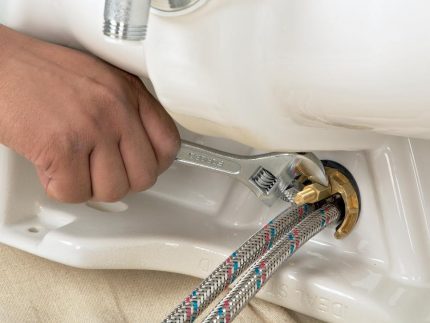
The mixer is ready. Flexible hoses are connected to water pipes after a sink with a pedestal is fully installed.Note that the right valve should be responsible for cold water, and the left - for hot.
For safety reasons, it is undesirable for a hot water tap to fit under your right hand. If the temperature is too high, you can get burned. This is especially true for children who do not always know how to properly regulate water with a mixer.
Sewerage connection - put a bottle siphon
Before turning on the water to check the quality of the installation, put a siphon and plug it in. As a rule, the siphon is sold unassembled, so it still needs to be assembled correctly.
Find a part for the drain hole. Use silicone to connect it to the gasket. Insert a bolt into the hole in the center. Put the drain in its place in the bowl of the sink with a pedestal.

If the sink has an overflow hole, it must also be connected to the siphon using a corrugated tube.
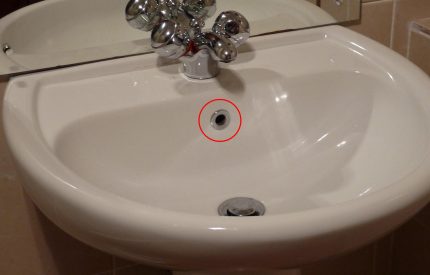
Collect a siphon bottle, connect it to a tee to connect overflow. All conical gaskets should be installed so that their narrow part is directed towards the union nut. Using a bolt, screw the siphon to the sink drain with a pedestal.
The design of the siphon is such that if a leak occurs in any connection, you will have to unwind and reassemble most of the parts. That is why the installation must be done carefully - the first time. The siphon is connected to the exhaust pipe after hanging the sink with a pedestal in place.
Mounting a sink - how to hang it on a wall
Now the marking is ready, the mixer and siphon are installed, you can proceed with installation. If you have little experience in this matter, the following instructions will be very useful for you. Using a hammer or drill, make holes in the concrete at the desired points.
The diameter of the drill is selected in accordance with the size of the dowels. The hole should be slightly smaller so that the mount fits snugly into the wall material.
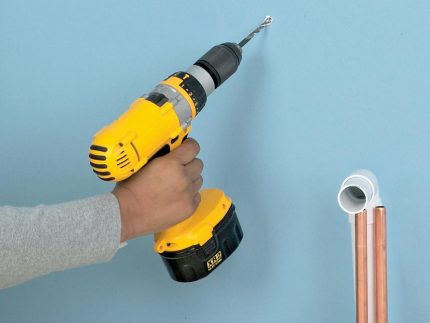
For strength, you can use adhesive sealant or silicone. It is poured directly into the holes before hammering the dowel there. The set for fastening includes special screws - plumbing screws.
At one end they are screwed into the wall, on the other hand, a thread is cut. Simple self-tapping screws with a screwdriver head or anchor bolts can also be used.

In order not to damage the enamel of the ceramic product, use the plastic washers, which are also included in the kit.
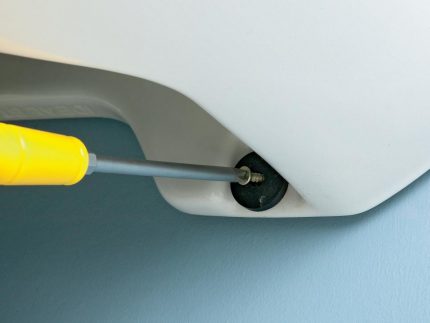
Replace the bowl and tighten the nuts. Verify the installation using the level. Installation of the main part of the washbasin with a pedestal is completed. Now you can do the plumbing and sewer connection. Since you followed the wiring diagram and brought out all the communications at the right points in advance, connecting the mixer and siphon will be easier than ever.
Pedestal Installation - Final Stage
The installation of the pedestal should be done after the siphon and mixer are connected. He will hide all communications, therefore, in the process of summing up the water supply and sewerage, you need to “try on” the pedestal so that pipes are not visible.
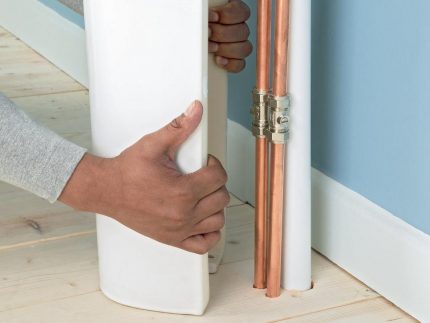
By itself, the “leg” for the washbasin is stable. When you put the siphon inside the sink stand, slide it against the wall. The bowl will rest on a pedestal and at the same time fix it with its weight.
The shortened pedestal does not rest on the floor. It will hang on mounting studs, like a sink. Even at the stage of installing the bowl, you need to take care of the holes for attaching the semi-pedestal. Then, in the same way, the product is hung on the studs, the washers are put on and the nuts are tightened.
Installation errors, their causes and methods of solution
Sometimes after the installation is completed or after some time after installation, it turns out that the sink with a pedestal is installed poorly.
A number of symptoms that indicate this:
- the shell is staggering;
- the pedestal staggers;
- there is a gap between the bowl and the pedestal;
- there is a gap between the bowl and the wall.
Most of these problems can be solved without dismantling the product. If your washstand on the pedestal began to walk and tremble with one touch - the problem is level. During the installation, of course, you used the spirit level, but perhaps not hard enough.
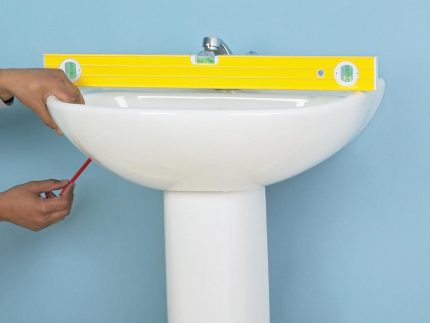
If it turned out that the mounts are not on the same level - this needs to be fixed. The big difference in height is corrected only with new fasteners, and the small one can be fixed by twisting the fastening pin a little.
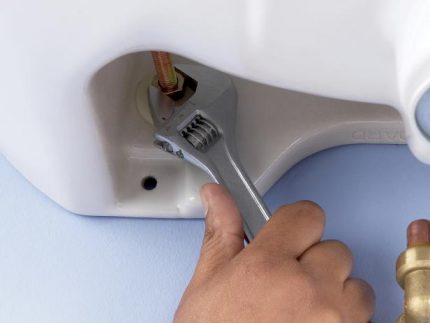
If the washbasin itself is held steady and only the pedestal staggers, the problem is at the bottom. A perfectly flat floor is a rarity. Maybe your pedestal has hit the joint of the floor slabs or the problem is in the screed itself, but if you do not want to level the floor, use silicone.
Drying, it creates a fairly dense layer that compensates for skew. Walk in silicone at the junction of the “legs” and the floor. The same solution is suitable for eliminating the gap near the wall or between the bowl and the pedestal. Silicone sealant is an indispensable thing in the plumbing arsenal.
Conclusions and useful video on the topic
Of course, it’s better to see once than read 100 times on the Internet. We have made a selection of good video reviews that will help to dot all the “and” in such a difficult task as installing a sink with a pedestal.
Video # 1. Installing a sink with a pedestal in a practical example:
Video # 2. Special attention to sealing joints:
If you still decide to install a sink with a pedestal without professional help, re-read all the recommendations twice, especially if you will do it for the first time. Of course, unforeseen situations may arise, no one is safe from this.
Being theoretically savvy, you will see a complete picture of the process. If you carefully follow the instructions, everything should go smoothly.
Want to talk about how you installed a tulip shell yourself? Have questions that arose during the review of the article, or useful information that you would like to share with us and visitors to the site? Please write comments in the block below.

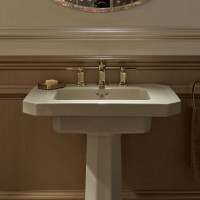 How to install a tulip shell on your own: phased instruction
How to install a tulip shell on your own: phased instruction 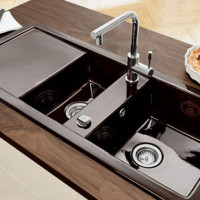 How to install a sink in the kitchen: installation rules for mortise and freestanding models
How to install a sink in the kitchen: installation rules for mortise and freestanding models 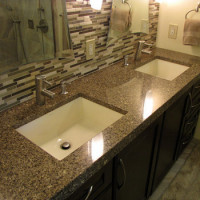 Countertop for the bathroom under the sink: types, how to choose and install correctly
Countertop for the bathroom under the sink: types, how to choose and install correctly 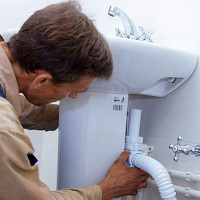 Bathroom sink with pedestal: installation and connection technology
Bathroom sink with pedestal: installation and connection technology 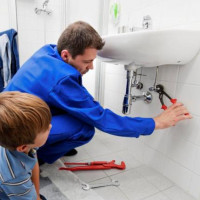 How to fix the bathroom sink to the wall: a detailed instruction on how to fix it
How to fix the bathroom sink to the wall: a detailed instruction on how to fix it 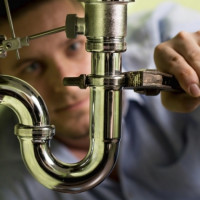 Installing a siphon in the kitchen: how to assemble and install a device + circuits and installation example
Installing a siphon in the kitchen: how to assemble and install a device + circuits and installation example  How much does it cost to connect gas to a private house: the price of organizing gas supply
How much does it cost to connect gas to a private house: the price of organizing gas supply  The best washing machines with dryer: model rating and customer tips
The best washing machines with dryer: model rating and customer tips  What is the color temperature of light and the nuances of choosing the temperature of the lamps to suit your needs
What is the color temperature of light and the nuances of choosing the temperature of the lamps to suit your needs  Replacement of a geyser in an apartment: replacement paperwork + basic norms and requirements
Replacement of a geyser in an apartment: replacement paperwork + basic norms and requirements
I decided to try to change the system myself. I was not seriously engaged in plumbing, so a number of questions arose. 1. Do all faucets have a standard distance between the cranes of the cold mountains, or do you need to measure yours before dismantling? 2. Which hoses are preferable: a metal hose or rubber, from an environmental point of view? 3. How to seal the connection if the factory gaskets do not hold well (water is oozing)? On the third question I really need help, I'm tired of substituting pots, I don’t have my strength ... Thanks in advance.
Answering your questions, I can say that 1) Why do you need to measure the distance between the taps? Not very clear. If in doubt, take a similar faucet, since there are plenty of them on the market. 2) I do not know how from the point of view of ecology, but from the point of view of reliability, the first option is much more preferable. 3) Take and change the gasket. Maybe she was sick, maybe she was married, maybe she was not installed correctly. It is enough to sort out the mixer and check everything. After that, draw conclusions. Gaskets are inexpensive.
I don’t really like it when the sinks are attached to the wall without support, such a design seems to me unsure and unreliable. Perhaps this is more than my nit-picking, but it was precisely these tulips that were planted at different times for myself and my brother. The pipes are hidden; nothing else needs to be removed. The most important thing is to choose a height suitable for growth, and measure everything with a level, so that the sink does not stagger.